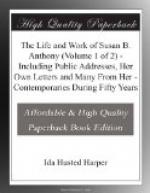A young teacher by the name of Brigham also attempted to define the spheres of Mrs. Mott, Mrs. Stanton[15] and the other great advocates of woman’s freedom and declared: “Women ought to be keepers at home and mind domestic concerns; he had no doubt the true object of this meeting was not so much to acquire any real or supposed rights as to make the speakers and actors conspicuous; he wished to urge upon them to claim nothing masculine for women, for even in animals the spheres were different. He had no objections to woman’s voice being heard, but let her seek out the breathing-holes of perdition to do her work.” Mr. Brigham was badly worsted in the argument which followed, and at the next session he sent in a protest, declaring he had not had “justice.” He evidently did not see the satire of this complaint, since he himself had been loudest in his refusal to do justice to woman.
A heated discussion was called out by a resolution offered by Rev. Antoinette L. Brown declaring that “the Bible recognizes the rights, privileges and duties of woman as a public teacher, as in every way equal with those of man; that it enjoins upon her no subjection that is not enjoined upon him; and that it truly and practically recognizes neither male nor female in Christ Jesus.” Mrs. Rose closed the discussion by saying:
I can not object to any one’s interpreting the Bible as he or she thinks best; but I do object that such interpretation go forth as the doctrine of this convention, because it is a mere interpretation and not even the authority of the Book; it is the view of Miss Brown only, which is as good as that of any other minister, but that is all. For my part I reject both interpretations. Here we claim human rights and freedom, based upon the laws of humanity, and we require no written authority from Moses or Paul, because those laws and our claim are prior even to these two great men.
Miss Brown’s resolution was not adopted. Susan B. Anthony spoke briefly but earnestly in behalf of the People’s College and also of the Woman’s State Temperance Society, for which she asked their endorsement. She then read the resolutions sent by Mrs. Stanton, all but one of which were adopted. The Syracuse Journal commented: “Miss Anthony has a capital voice and deserves to be made clerk of the Assembly.” The Syracuse Standard said of this convention: “It was attended by not less than 2,000 persons. The discussions were characterized by a degree of ability that would do credit to any deliberative body.” The Journal said: “No person can deny that there was a greater amount of talent in the woman’s rights convention than has characterized any public gathering in this city during the last ten years, if ever before. The appearance of all the ladies was modest and unassuming, though prompt, energetic and confident. Business was brought forward, calmly deliberated upon and discussed with unanimity and in a spirit becoming true women, which would add an unknown dignity to the transactions of public associations of the ‘lords.’” The Syracuse Star, however, took a different view:




